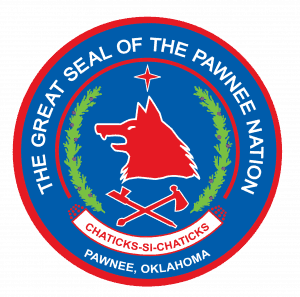Culture - Pawnee Nation Flag and Seal

Pawnee Nation Flag
The miniature stars and stripes of the blue field symbolize America. The Plains Indian tribes called the Pawnee "Wolves" because of their cunning and courage. Thus, the emblem of the wolf was created and retained the double meaning of "Chaticks si Chaticks" or Men of Men.
Crossed on the blue field is a peace pipe and tomahawk; the peace pipe standing for peace and the tomahawk for war.
Below are Nine arrowheads emblematic of the wars in which the Pawnees fought in the service of their country; the Indian wars, the Spanish-American War, World War I, World War II, Korean War, Vietnam War, Desert Storm, Operation Enduring Freedom, and Operation Iraqi Freedom.
The flag means Pawnee Indians, in peace and war, are always courageous and loyal to America.
The flag staff is an old time Pawnee lance with a genuine flint spearhead.
The staff has bead work mounted on buckskin opposite the blue field. The many colors in the bead work symbolize our various ceremonies and our old people who have gone on before us.
The four prime eagle feathers attached at the top of the flag represent the four Pawnee bands: Chaui, Pitahawirata, Skidi and Kitkehahki.
A sprig of cedar should be attached to the staff during Homecoming, Armistice Day, Christmas and on occasions of state. We use cedar in sacred ceremonies and in prayer. It is a token of prayer and a token of peace.
Like the flag of the United States, the Pawnee Indian Flag should never be desecrated and it should never touch the ground.
The Pawnee Nation Flag was designed by Brummett EchoHawk.

Pawnee Nation Seal
The Wolf- The Plains Indians referred to the Pawnees as "Wolves" due to their cunning and courage.
The Banner- "Chaticks si Chaticks" in Pawnee Language, means "Men of Men"
Sprigs of Cedar- The Pawnee use cedar in sacred ceremonies and in prayer. It is a token of prayer and peace.
The Morning Star- The Morning Star symbolizes God. The Skidi believed that this star is where God lived.
The Peace Pipe and Tomahawk- The Peace Pipe standing for peace and the Tomahawk for war. Pawnee Colors - Red for Courage. White for Purity. Blue for Truth.
The original Seal was designed by Brummett Echohawk.

Pawnee Nation Flag
The miniature stars and stripes of the blue field symbolize America. The Plains Indian tribes called the Pawnee "Wolves" because of their cunning and courage. Thus, the emblem of the wolf was created and retained the double meaning of "Chaticks si Chaticks" or Men of Men.
Crossed on the blue field is a peace pipe and tomahawk; the peace pipe standing for peace and the tomahawk for war.
Below are Nine arrowheads emblematic of the wars in which the Pawnees fought in the service of their country; the Indian wars, the Spanish-American War, World War I, World War II, Korean War, Vietnam War, Desert Storm, Operation Enduring Freedom, and Operation Iraqi Freedom.
The flag means Pawnee Indians, in peace and war, are always courageous and loyal to America.
The flag staff is an old time Pawnee lance with a genuine flint spearhead.
The staff has bead work mounted on buckskin opposite the blue field. The many colors in the bead work symbolize our various ceremonies and our old people who have gone on before us.
The four prime eagle feathers attached at the top of the flag represent the four Pawnee bands: Chaui, Pitahawirata, Skidi and Kitkehahki.
A sprig of cedar should be attached to the staff during Homecoming, Armistice Day, Christmas and on occasions of state. We use cedar in sacred ceremonies and in prayer. It is a token of prayer and a token of peace.
Like the flag of the United States, the Pawnee Indian Flag should never be desecrated and it should never touch the ground.
The Pawnee Nation Flag was designed by Brummett EchoHawk.

Pawnee Nation Seal
The Wolf- The Plains Indians referred to the Pawnees as "Wolves" due to their cunning and courage.
The Banner- "Chaticks si Chaticks" in Pawnee Language, means "Men of Men"
Sprigs of Cedar- The Pawnee use cedar in sacred ceremonies and in prayer. It is a token of prayer and peace.
The Morning Star- The Morning Star symbolizes God. The Skidi believed that this star is where God lived.
The Peace Pipe and Tomahawk- The Peace Pipe standing for peace and the Tomahawk for war. Pawnee Colors - Red for Courage. White for Purity. Blue for Truth.
The original Seal was designed by Brummett Echohawk.
![Approved Pawnee Nation Seal[1085] Approved Pawnee Nation Seal[1085]](https://b2131152.smushcdn.com/2131152/wp-content/uploads/2020/12/Approved-Pawnee-Nation-Seal1085-e1609779163393.png?lossy=1&strip=1&webp=1)